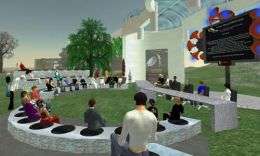November 7, 2007 weblog
University of Tokyo Expands Second Life Type Games

A team of undisclosed researchers at the University of Tokyo have a prototype in development that will bring the public one step closer to entering the Virtual World.
A team of researchers at the University of Tokyo is in the development stage of presenting an important addition to games like Second Life. The project has not released the details of the work, but Nikkei dot net and Digital World Tokyo have unearthed some fascinating details of the innovation research in progress. The virtual reality prototype allows players to walk around the game environment like explorers examining the various on screen environments.
The prototype is a waist mounted camera and a companion specially designed carpet that has fixed points of reference assigned and calibrated for movement in the real world. The apparatus interprets these real world movements into the virtual world either through a headset or big screen display.
While neither sources cited which lab or department at the University of Tokyo is working on this almost limitless innovation, there are some likely leaders in the area. An interview by University of Tokyo students with Professor Hirose, Michitaka in 2004 explained the future of "expanded virtual reality," as it extends to space and time.
Professor Hirose, Michitaka is head of the Intelligent Cooperative Systems lab. He explained how going back to the 1990s the virtual world was contained in a box--the computer. His work and others have extended the virtual world to include wearable computers being researched by Ms. Ueoka and virtual experience in ordinary places by Mr. Yamashita. The limitless bounds of virtual reality is the focus of Professor Hirose, Michitaka´s lab.
The professor characterized the two schools of virtual reality research. The first is devoted to developing wearable head gear and mobile apparatus The other is devoted to exploring the five senses of human beings. He pointed out that beneath the two there may lay an inner connection.
In previous public exhibitions the professor and his collaborators have introduced the CABIN that allowed visitors to step into the huge screens of the display. In addition, another Mayan Civilization display allowed visitors to view a virtual space of information technology and content. The professor is cognizant of the importance of reaching the public at large for promoting the future of virtual reality.
In other projects, his team has endeavored to create a 21st century time machine. The Lifelog Project was initially developed to create an oral history of human actions, but has expanded to the ability to predict future actions based upon simulations that can be run through the computer. It is a small wearable device that records human interaction. The complexities of this work defy imagination, but appear to be just another day in the lab for the professor.
In a quote from the interview, the professor stated that "the real world is becoming virtualized... and the world of information is free to move forward or backward." His concern for the future is that while some view the freedom to be a dangerous, "if we free up our imagination, we can develop many interesting things from here."
For further reading on the subject, please see:
www.rcast.u-tokyo.ac.jp/en/res … iles/002/pdf/001.pdf





















